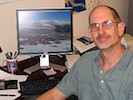|
Webinar #43 - Thursday, December 10, 2015 "Radiosondes, it’s what’s overhead that counts"
Paul Ciesielski
Colorado State University
Fort Collins, CO
 
(biography)
A radiosonde (sonde is French and German for probe) is a battery-powered telemetry instrument package carried into the atmosphere usually by a weather balloon that measures various atmospheric parameters and transmits them by radio to a ground receiver. Radiosondes are an essential source of meteorological data, and hundreds are launched all over the world daily. In this talk I will discuss a brief history of radiosondes, different types of sondes, what sondes measure and how, where soundings are taken, and how the data collected by radiosondes are used.

View the Webinar by clicking here: https://youtu.be/5Nd4pyAn_xs
View Paul's presentation slides  (38MB) (38MB)
Resources:
How a radiosonde is launched: https://www.youtube.com/watch?v=AoUxq4mTv5M Looking at upper-air data: http://weather.rap.ucar.edu/upper/ Getting upper-air data: http://weather.uwyo.edu/upperair/sounding.html
“WMO GUIDE TO METEOROLOGICAL INSTRUMENTS AND METHODS OF OBSERVATION” on (Ch#12 and #13): http://www.wmo.int/pages/prog/www/IMOP/CIMO-Guide.html Radiosonde museum: http://radiosondemuseum.org/
Cameras launched on weather balloons:
https://www.youtube.com/watch?v=veqJART9XBA https://www.youtube.com/watch?v=y6ZMscMp8UM
|